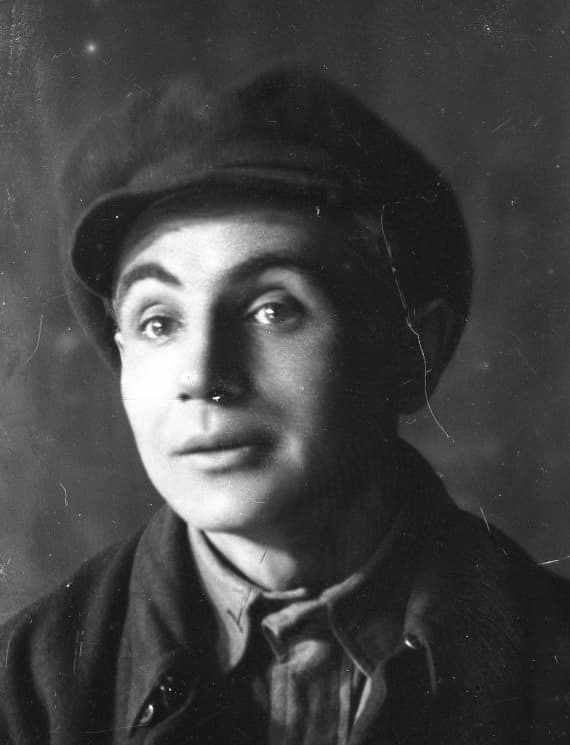Based on the play by Ernst Toller
Premier: January 6, 1924
Director: Favst Lopatynskyi
Artist: Vadym Meller
Assistant Director: O. Savytskyi
Set Engineer: Kostiantyn Kalinin
Scenery made at the Berezil metalwork workshop
Prologue:
Lord Chancellor – V. Vasylko
Lord Byron – A. Buchma, K. Elanskyi
Lord A – Y. Hirniak
Lord B – H. Drozd
Lord C – K. Dekhtiarenko
Lord D – L. Shudebil
Lord E – V. Stukachenko
Lord F – D. Reva
Lord G – P. Artykula
Workers – D. Babenko, S. Bondarchuk, S. Blahyi, S. Humeniuk, Y. Hudzenko, M. Derkach, A. Dzhuddi, P. Dolyna, M. Ilchenko, I. Marianenko, K. Muzychenko, A. Tymoshivskyi, F. Radchuk, A. Serdiuk, O. Suprun, Yatchenko
Messengers – O. Podorozhnii, O. Shvachko
Town Crier – K. Blakytnyi, A. Buchma
Act 1
Jimmy Cobbett – A. Buchma, K. Elanskyi
Children – P. Niatko, T. Myrhorod, O. Dobrovolska, H. Lor, S. Manuilovych
Beggar – V. Vasylko
Ned Lud – I. Marianenko
John Wibley – P. Dolyna
Henry Cobbett – Y. Hirniak
Mother – A. Smereka, H. Babiivna
Ure – S. Karhalskyi
Teddy – O. Dobrovolska
Struggle Personified – M. Derkach
Jimmy and John – O. Shvachko
Act 2
First Drunkard – F. Radchuk
Second Drunkard – L. Serdiuk
Albert – D. Reva
Foreman – H. Drozd
State Inspector – S. Humeniuk
Women:
First Pair – H. Babiivna, O. Steshenko
Second Pair – P. Niatko, E. Petrova
Act 3
Engineer – K. Dekhtiarenko
Crowd:
Women – V. Antonivska, H. Babiivna, Z. Viktorzhevska, O. Dobrovolska, P. Karlash, N. Karpenko, H. Lop, S. Manuilovych, T. Myrhorod, P. Niatko, V. Panchenko, E. Petrova, H. Pylypenko, H. Pukha, A. Smereka, O. Steshenko, O. Strutynska, Ts. Trush, M. Kharchenko
Men – P. Artykula, D. Babenko, S. Blahyi, Ya. Hudzenko, M. Derkach, A. Dzhuddi, M. Drozd, K. Dekhtiarenko, M. Ilchenko, K. Muzychenko, O. Podorozhnii, D. Potapiv, M. Petrashevych, F. Radchuk, D. Reva, L. Serdiuk, I. Skurativskyi, V. Stukachenko, O. Suprun, A. Tymoshivskyi, F. Tynda, O. Shvachko, F. Yatchenko
The Machine Wreckers, based on the play by German playwright Ernst Toller and directed by Favst Lopatynskyi, appeared on the stage of the Berezil Artistic Association immediately after Les Kurbas’s epochal Gas and Jimmie Higgins. The response to the shows was so strong that subsequent productions by Berezil were compared with them, as Kurbas’s students sought to impress audiences no less than their teacher. One newspaper wrote: “In Gas Berezil demonstrated collective creativity, in Jimmie Higgins in was the brilliant acting of the individual actors. The Machine Wreckers showed that new directors are also maturing in this artistic association. Comrade Lopatynskyi is one of those who deserves much attention.”
However, along with the positive feedback and advances on future successes, the critics couldn’t help but see major weaknesses – and in the competition between student and teacher, the teacher remained at an unattainable height. One reporter, who called Kurbas’s shows “alive,” didn’t see this life in Lopatynskyi’s production. “The Machine Wreckers,” he wrote, “gives the impression of something very cerebral, very important. The work’s detachment from life leaves the viewer indifferent.”
The play is about a rebellion by English factory workers during which they destroyed machines out of fear that they would lose their jobs due to the automation of production. Petro Terniuk, who researched Ivan Marianenko’s work, wrote that in The Machine Wreckers the director immediately proclaimed that “the strongest enemy of a director is the author, who should be defeated at any cost.” Favst Lopatynskyi took liberties with The Machine Wreckers much the same way he did when staging Efim Zozulya’s The New Ones Advance. In the journal Theater Barricades, he responds to critics with a touch of good humor: “Reviewers! Poor Comrade Zozulya had the misfortune of falling into my hands in my previous production (The New Ones Advance). (I’d write him an apology letter but I don’t know his address). Now here’s a request: don’t curse Toller. He is a very nice person, and besides, there’s only 10% of him left in the play! Curse me! I am the only one at fault here!”
The critics were divided over the play: after the first act there was enthusiasm and long applause, but the second to the fourth left them tired and uninterested. As theater critic Natalia Yermakova noted, Lopatynskyi, with his youth and lack of experience, couldn’t surpass Kurbas’s expressionist masterpiece Gas and noticeable lost to him.
Nevertheless, the show had its strong points. Critics noted the virtuosity in creating mass scenes, the well-crafted and clear polyphonic recitation by the actors, and the effect of the wheel that spun during the show and in the end fell victim to the workers, who saw the “devilish monster” as an enemy.
To quickly change scenes, Lopatynskyi came up with the idea of using a huge wheel and curtains that opened and closed different parts of the stage. To make this grandiose idea come to life he hired engineer Kostiantyn Kalinin to create the moving parts of the scenery. At the time, Kalinin was the head of the design bureau at the Kyiv Aviation Plant “Remvosdukh-6.” He designed his first plane in 1925 and later went down in history as an aircraft designer and pilot. Vadym Meller was the production artist and creator of the multi-level structures and costumes.
Theater reviewers praised the brilliant ensemble of actors. Some critics rediscovered already well-known Berezil actors, such as Amvrosii Buchma, who played Jimmy Cobbett, the idealistic leader of the workers who dies tragically in the end, and Ivan Marianenko, who played Ned Lud.
“The actors somehow sound new,” wrote poet and critic Yakiv Savchenko. “They’re the same, but not… Each one of them surprises and delights. Especially Buchma and Marinenko, who are strong monoliths.” The critics praised them, but not all the actors were happy about the discovery of their new sides. Marianenko as Ned Lud was told by the director to supposedly merge with the wheel and slowly slide down it. The experienced actor wasn’t enthusiastic about this mise-en-scène, but he was ready to try the young director’s experiment at using new techniques. Lopatynskyi had visualized the idea of the organic merging of actor and machine, “the moving part of the dead with living material.” He wanted in the play for the “machine, having joined in union an employee of the theater, to reproduce a common dynamic.”
Actor Vasyl Vasylko created an interesting visual image in The Machine Wreckers. He recalled that he played two roles at once – a beggar and a lord. He had been instructed by the director to only appear on stage in profile and instantly transform from a young beardless man to an old man with a gray beard, dressed in rags and carrying a crutch.
The Berezil production, as always, provoked heated discussions. Despite the many criticisms, The Machine Wreckers was a notable artistic phenomenon. “Aesthetically, Berezil’s machine wreckers appeared on the intersection of expressionism and constructivism and took a prominent place among the most radical examples of Ukrainian avant-garde,” Natalia Yermakova wrote. Poet, critic and ardent supporter of the show Yakiv Savchenko noted: “F. Lopatynskyi is a young director. The Machine Wreckers is his second debut. But we can already say without hesitation that Lopatynskyi is a master.”

